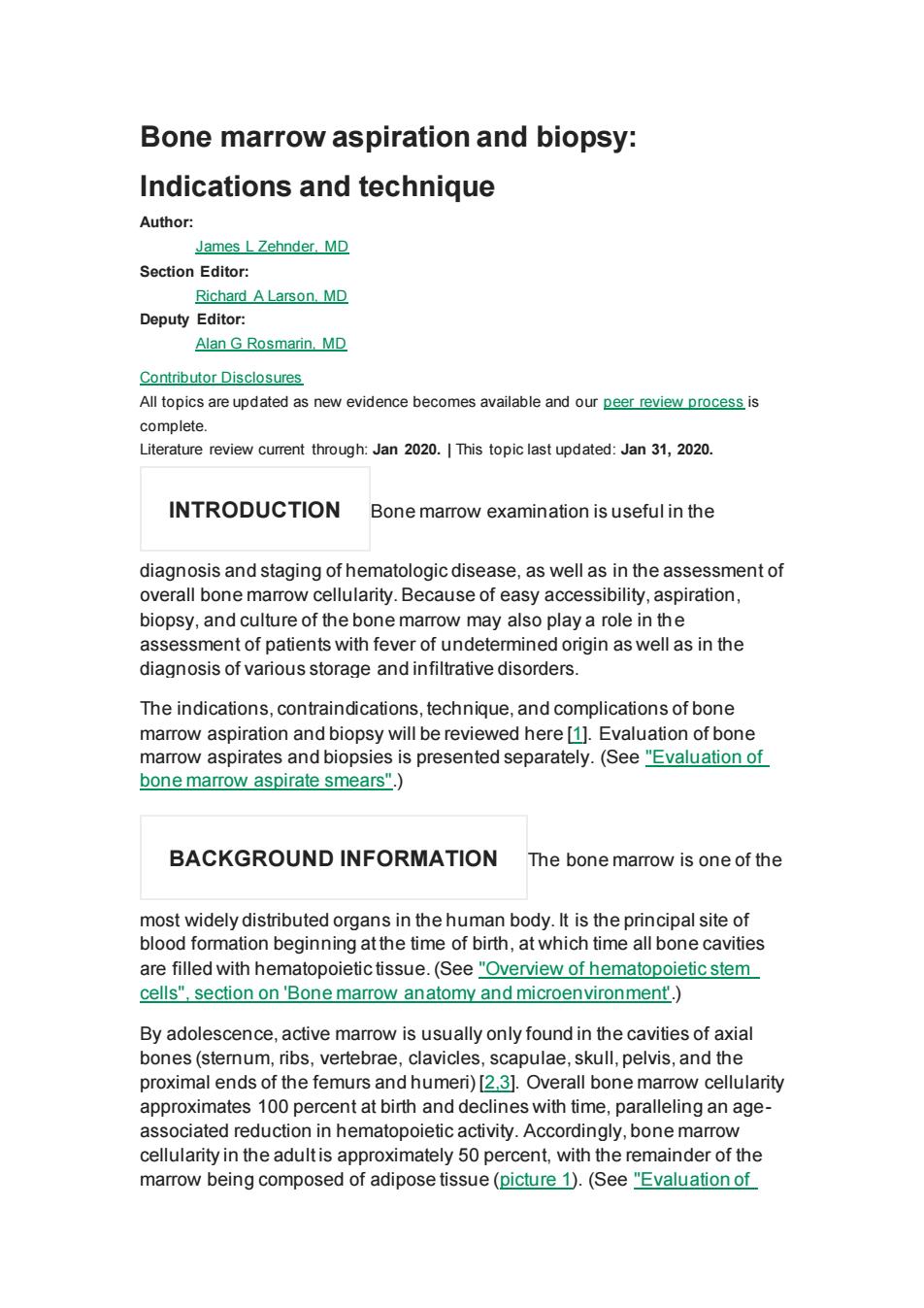正在加载图片...

Bone marrow aspiration and biopsy: Indications and technique Author: James LZehnder.MD Section Editor: Richard Alarson MD Deputy Editor: Alan G Rosmarin.MD Contributor Disclosures All topics are updated as new evidence becomes available and our peer review process is complete. Lite ature review current through:Jan 2020.This topic last updated:Jan 31,2020. INTRODUCTION Bone marrow examination is useful in the diagnosis and staging of hematologic disease,as well as in the assessment of overall bone marrow cellularity.Because of easy accessibility,aspiration, biopsy.and culture of the bone marrow may also play a role in the assessment of patients with fever of undetermined origin as well as in the diagnosis of various storage and infiltrative disorders. The indications,contraindications,technique,and complications of bone marrow aspiration and biopsy will be reviewed here [1].Evaluation of bone marrow aspirates and biopsies is presented separately.(See "Evaluation of bone marrow aspirate smears".) BACKGROUND INFORMATION The bone marrow is one of the most widely distributed organs in the human body.It is the principal site of blood formation beginning at the time of birth,at which time all bone cavities are filled with hematopoietic tissue.(See "Overview of hematopoietic stem cells"section on'Bone marrow anatomy and microenvironment.) By adolescence,active marrow is usually only found in the cavities of axial bones(sternum,ribs,vertebrae,clavicles,scapulae,skull,pelvis,and the proximal ends of the femurs and hu mer i)[23.Overall bone m approximates 100 percent at birth and declines with time,paralleling an age- associated reduction in hematopoietic activity.Accordingly,bone marrow cellularity in the adult is approximately 50 percent,with the remainder of the marrow being composed of adipose tissue(picture 1).(See"Evaluation of Bone marrow aspiration and biopsy: Indications and technique Author: James L Zehnder, MD Section Editor: Richard A Larson, MD Deputy Editor: Alan G Rosmarin, MD Contributor Disclosures All topics are updated as new evidence becomes available and our peer review process is complete. Literature review current through: Jan 2020. | This topic last updated: Jan 31, 2020. INTRODUCTION Bone marrow examination is useful in the diagnosis and staging of hematologic disease, as well as in the assessment of overall bone marrow cellularity. Because of easy accessibility, aspiration, biopsy, and culture of the bone marrow may also play a role in the assessment of patients with fever of undetermined origin as well as in the diagnosis of various storage and infiltrative disorders. The indications, contraindications, technique, and complications of bone marrow aspiration and biopsy will be reviewed here [1]. Evaluation of bone marrow aspirates and biopsies is presented separately. (See "Evaluation of bone marrow aspirate smears".) BACKGROUND INFORMATION The bone marrow is one of the most widely distributed organs in the human body. It is the principal site of blood formation beginning at the time of birth, at which time all bone cavities are filled with hematopoietic tissue. (See "Overview of hematopoietic stem cells", section on 'Bone marrow anatomy and microenvironment'.) By adolescence, active marrow is usually only found in the cavities of axial bones (sternum, ribs, vertebrae, clavicles, scapulae, skull, pelvis, and the proximal ends of the femurs and humeri) [2,3]. Overall bone marrow cellularity approximates 100 percent at birth and declines with time, paralleling an ageassociated reduction in hematopoietic activity. Accordingly, bone marrow cellularity in the adult is approximately 50 percent, with the remainder of the marrow being composed of adipose tissue (picture 1). (See "Evaluation of